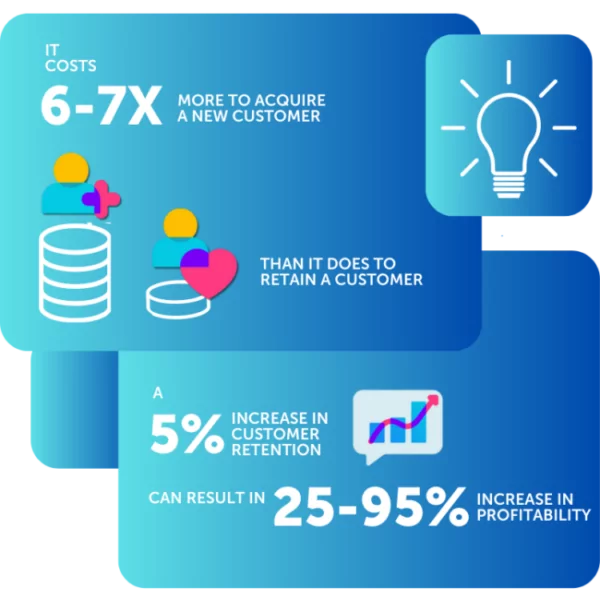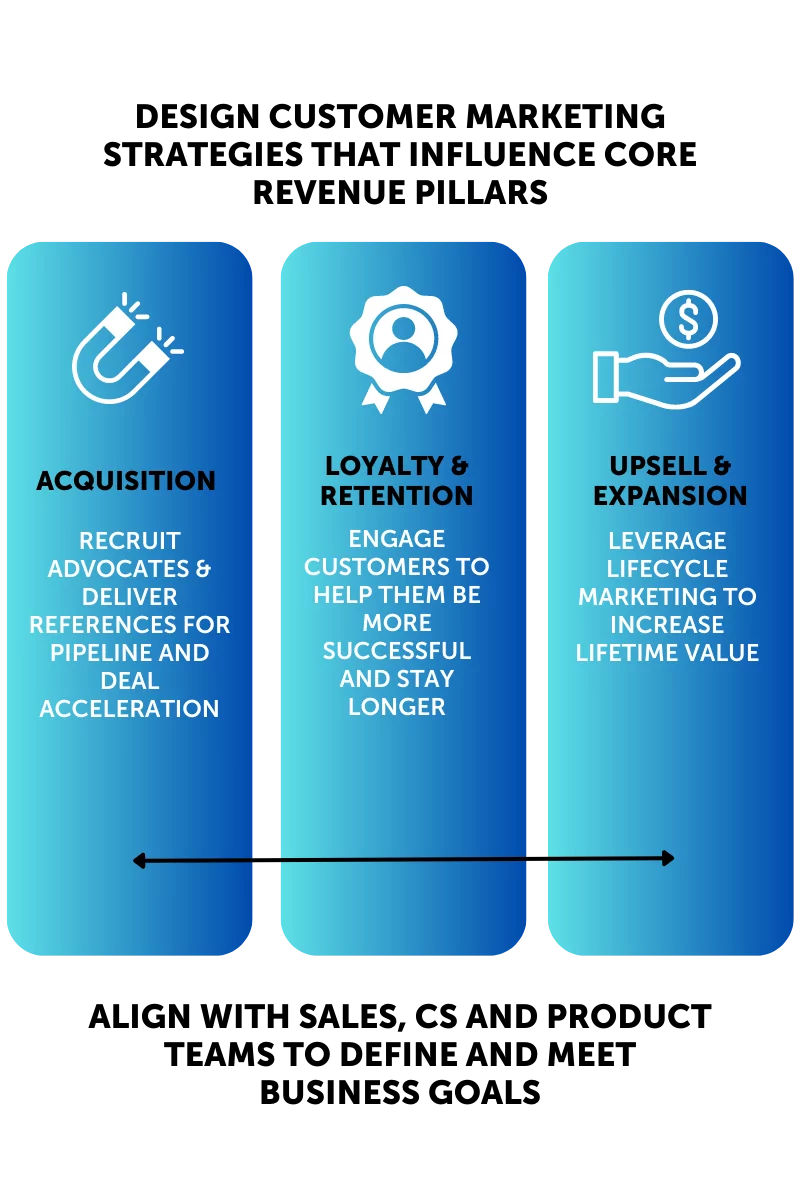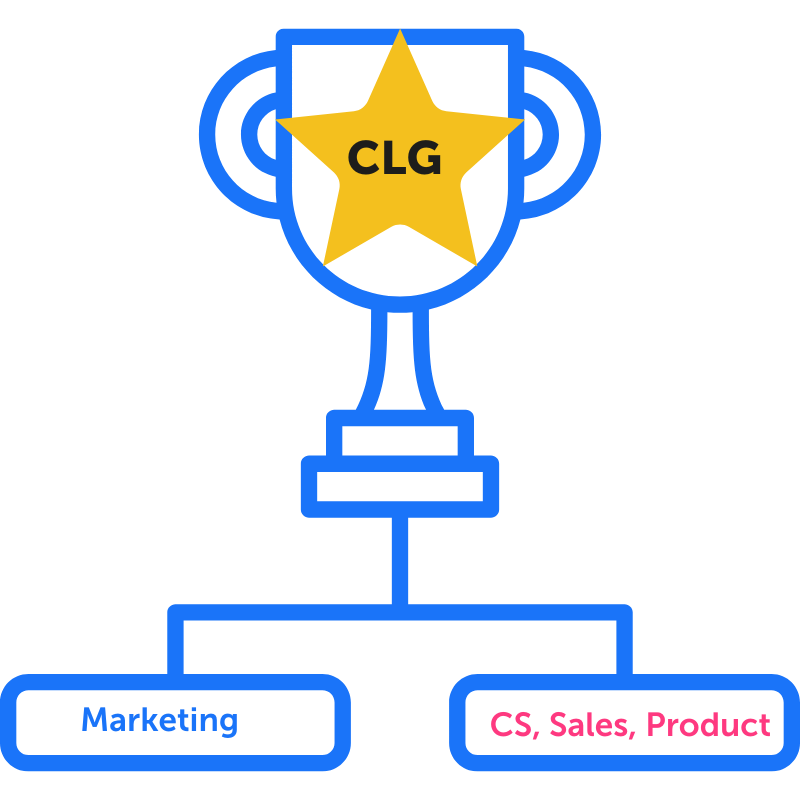- Home
- A Guide to Customer Marketing
Everything you need to know about Customer Marketing
The Comprehensive Guide
Under the duress of the global downturn and changing buyer behaviors, Customer Marketing has evolved with new trends and techniques that businesses need to embrace to unlock sustainable growth.
This guide provides an in-depth and detailed overview of Customer Marketing, its significance, strategies, and best practices, and explains how businesses can leverage it to achieve their goals.

Customer Marketing has emerged as a pivotal strategy for any B2B SaaS vendor today.
Why? Because its influence goes far beyond simply increasing customer loyalty.
Customer Marketing is emerging as the new B2B marketing strategy, because when your customers are happy and successful they will not only stay and buy more from you, they will serve as your advocates in the market, helping to increase demand and generate leads in a manner that is far more effective and cost-effective than anything the industry has known. Even during the best of times.
Understanding Customer Marketing
Take your customers on a journey from engagement to revenue
Customer Marketing is a strategy that focuses on Customer-Led Growth (CLG). It means directing your marketing efforts towards existing customers and providing personalized experiences that engage and add value.
With CLG, two important things happen: your customers become more valuable over time, and you acquire new customers more efficiently. By nurturing your customer base, you increase their engagement, encourage them to use your product more, and get them to stick around longer. This leads to loyalty, more opportunities for upselling and expanding your offerings, and ultimately higher customer value.
Moreover, when your customers become advocates, they become a powerful asset for acquiring new customers. Through referrals, testimonials, reviews, and their social presence, they help bring in new business more effectively.
CLG puts your customers at the heart of your marketing strategies. It recognizes the importance of building and maintaining strong relationships with them over the long term. Customers are seen as partners, and the goal is to create mutual growth by providing value and fostering win-win collaborations. This approach creates a positive cycle where revenue generated by customers drives continuous growth.

The Importance of Customer Marketing
In the ever-evolving landscape of marketing, Customer Marketing has become increasingly vital and impactful.
As we navigate the dynamic world of B2B marketing, embracing the power of a Customer-led strategy becomes increasingly crucial for success. Here's why:

Boost Customer Retention: Keeping Customers Happy and Loyal
Retaining existing customers is not only easier but also far more cost-effective than acquiring new ones. Customer Marketing plays a crucial role in this aspect by engaging customers throughout their journey. By influencing their adoption, encouraging community interaction, and emphasizing the value they receive, different customer programs are tailored to match each customer's lifecycle stage. These initiatives motivate users and companies to unlock the full potential of your product and brand.
Unlock Customer Advocacy: Leveraging Happy Customers
Engaged and empowered customers more readily become enthusiastic advocates for your brand. They actively contribute to lead generation through testimonials, reviews, referrals, and sharing your content on social platforms. What's remarkable is that these customer-generated leads also convert at higher rates and require less investment. Additionally, customers who participate in reference calls expedite the sales cycle and drive sales velocity, contributing to overall business growth.

Increase Customer Lifetime Value (CLV): Long-Term Revenue
Customer marketing enables you to increase Customer Lifetime Value (CLV) by implementing personalized programs and campaigns that engage customers effectively and deliver relevant and timely offers. By providing tailored experiences and incentives, you empower customers to fully utilize your product, unlock its maximum value, and subsequently increase their spending. This strategic focus on enhancing CLV not only ensures customer satisfaction but also drives long-term revenue growth.
Learn more about: Why B2B Firms Need To be Customer Obsessed
Retaining and Upselling to a Customer is Far More Cost-Effective Than Acquiring a New Customer
Download the Upsell/ Cross-sell Playbook

Emerging Trends in Customer Marketing
The Customer Marketing landscape is continuously evolving, and staying ahead of the curve is crucial.
Here are the emerging trends that demand attention:
- Personalization: Customers today crave tailored experiences. With advancements in AI and machine learning, businesses can now deliver personalized communication at scale, ensuring each customer feels valued and understood.
- Holistic Approach: Customers interact with brands across multiple channels and touch-points, and user preferences will also vary. There is no one-size-fits-all formula for effective engagement. Adopting an holistic approach means you must be up-to-date on each customer and user journey, and you have a program that reflects just that. Its about being geared to engage with all your customers, not just an elite group of executives or recruited advocates, and doing so in a manner that builds trust and credibility for your brand.
- Customer Experience Data: Customer journey or experience data holds immeasurable value for businesses but poses a challenge due to its multi source origin. Go-To-Market (GTM) teams, and Customer Marketers in particular, need to refer to a complete depiction of the customer and user journey to unlock engagements that can be leveraged for growth. Integration with the company CRM and any information coming in from Customer Success, Support and Sales, helps generate this depiction. It also provides a comprehensive view of each customer, enabling businesses to gain valuable insights and make informed decisions based on data-driven strategies.
- Connect the Dots: Tracking and demonstrating the impact of customer marketing on bottom line metrics is the most important capability to develop today. With economic challenges still on the rise, now is the time to make the case for customer marketing and continually evangelize the impact of a customer-led strategy, to secure buy-in for these programs and their ongoing development.
- Community-led Growth: With the rise of personalization and customer-led strategies, comes also the age of the Community. Customers, users, prospects and vendors, gather in communities to share knowledge, learn from the experience of others and exchange resources in an open, non-committal setting that evokes credibility and trust.
By embracing these emerging trends in customer marketing, businesses can create meaningful connections, drive customer engagement, and achieve success in today’s challenging marketplace.

Customer Marketing Strategies & Best Practices
To unlock the potential of customer marketing, businesses need to embrace customer-led strategies and adopt best practices:
- Deepen Customer Understanding: Employ customer segmentation and personas to gain profound insights into your customer base. Leverage data analytics to uncover valuable information about their behaviors, preferences, and needs.
- Craft a Customer Journey Map: Develop a comprehensive customer journey map that illustrates the entire customer experience, from initial brand contact to final interaction. This visual representation helps identify critical touchpoints for marketing and enhances customer satisfaction.
- Personalize Communication: Tailor your marketing messages and channels to align with customer experiences and preferences. Capitalize on advanced technologies like AI and machine learning to deliver personalized experiences at scale.
- Establish a Rewarding Advocacy Program: Create an advocacy program that rewards customers for their active participation in your marketing and thought leadership campaigns. Ensure that your program offers tangible value and spotlights your customers’ successes as well as yours.
- Harness User-Generated Content (UGC): Actively encourage the generation of user-generated content, such as customer reviews and testimonials. UGC serves as authentic social proof and contributes to brand promotion.
- Engage in Social Listening: Monitor social media platforms and online conversations related to your brand to gain insights into customer sentiment and respond promptly and appropriately.
- Glean product feedback: Make sure your customers know the relationship is a two-way conversation. Deliver their feedback to where it needs to go and close the loop by letting them know what will not be done.
By adopting customer marketing strategies and incorporating its best practices, businesses can build long-term relationships with their customers, drive customer loyalty, and achieve sustainable growth.

Building a Customer Marketing Team
Establishing a dedicated team is crucial for successful customer marketing implementation
Customer Marketing teams support customers throughout their entire lifecycle—from onboarding to product adoption to expansion to renewal and beyond. This translates to customers who stay longer (increasing Net Dollar Retention), use more of your product (increasing Lifetime Value) and refer more new customers (increasing New Revenue).
Here are key roles that businesses should consider when building a customer marketing team:
- Customer Marketing Manager: This role takes charge of the overall customer marketing strategy and oversees its execution. They are responsible for aligning customer marketing initiatives with business goals, coordinating cross-functional efforts, and driving results.
- Data Analyst: A data analyst plays a vital role in the customer marketing team by analyzing customer data and extracting actionable insights. They help identify patterns, trends, and customer behaviors that inform decision-making and shape effective marketing strategies.
- Customer Success Representative: The customer success representative focuses on ensuring customer satisfaction and maximizing their value. They act as a point of contact for customers, addressing their needs, resolving issues, and proactively engaging to drive long-term relationships.
- Content Strategist: A content strategist creates and manages customer-focused content that aligns with different stages of the customer journey. They develop engaging materials such as blog posts, case studies, and guides to nurture customer relationships and support marketing objectives.
- Social Media Manager: This role is responsible for managing the brand’s presence on social media platforms. They curate compelling content, engage with customers, and leverage social listening to gain insights and respond to customer feedback effectively.
In many cases, the Customer Marketing ‘team’ will start off with a headcount of one and grow from there as impact is achieved and demonstrated. The key is to start where you are, partner with teams across the business, and do what you can to set business-driven goals and meet them. A collaborative effort will pave the way for successful customer marketing campaigns and drive growth in the B2B landscape.

Measuring Success in Customer Marketing
To assess the effectiveness of your customer marketing strategies, you need to track relevant metrics.
Add science to the art of customer marketing by looking at the following numbers:
Customer Retention Rate:
This metric measures the percentage of customers you successfully retain over a specific period. A high retention rate indicates satisfied customers and the effectiveness of your customer marketing initiatives.
Net Promoter Score (NPS)

NPS measures customer loyalty and satisfaction by asking customers to rate how likely they are to recommend your brand. A higher NPS indicates a stronger customer advocacy and positive customer experiences.
Customer Lifetime Value (CLV):

CLV quantifies the total revenue a business can expect from a single customer account throughout their entire relationship with your company. Tracking CLV helps you understand the long-term value of your customer relationships and the effectiveness of your marketing efforts in driving revenue.
Customer Churn Rate:
Churn rate refers to the percentage of customers who stop doing business with you over a specific period. Monitoring this metric helps identify potential issues or areas for improvement in your customer marketing strategies to minimize customer attrition.
Brand Advocacy:
Brand advocacy can be measured through various indicators, such as the number of referrals, testimonials, and positive reviews generated by customers. A higher level of brand advocacy indicates successful customer marketing initiatives and satisfied customers who actively promote your brand.
Get the playbook for customer marketing success

Customer Marketing and Beyond
The road to CLG is paved with Customer Marketing Success
Customer marketing has emerged as a crucial strategy for businesses to achieve success in today's dynamic landscape. By prioritizing existing customers and delivering value to them, companies will enhance customer retention, foster brand advocacy, and ultimately drive profitability.
Where to now?
In the ever-evolving B2B landscape, it is imperative for organizations to adopt Customer Marketing strategies to stay relevant and competitive. We hope this guide has served as a valuable resource for understanding and implementing effective Customer Marketing practices in the current era and beyond.
Always keep in mind that the customer should be at the center of all your strategies and practices. Strive to understand their needs, exceed their expectations, and build long-lasting relationships that contribute to your business growth and success.
With this comprehensive guide, you’re now equipped to navigate the world of customer marketing. So, gear up and embark on your journey to creating exceptional customer experiences and driving business growth.
Know that we will be right there with you through every step of the way, and if you need to talk about your plans and best path forward, we’re totally up for it – no strings attached!



